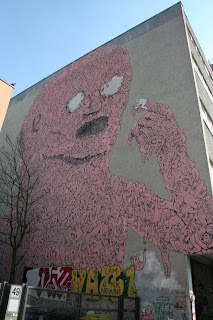
This was an interesting show, I really liked the work. the way it was set out wasn’t anything special, it was separated into 5 sections each with a different theme; The Most Perfect Picture, Devotional Pictures, Continual Uncertainty, Private Images, Personal Portraits.
It was your standard high brow show with lots of ‘guards’ marching up and down making sure we behave. I was wondering if some people enjoy this. If they know themselves they’re going to behave, they won’t have a problem, maybe they feel protected from the ‘rif-raf’.
Anyway, my phone went off an I was asked to take it outside.
On my way out I noticed a Francis Alys show being put up in a cornered off room. I asked at the desk what was going on and they said it would be open to the public the next day. Yesss!
After the Nation Portrait Gallery I headed towards the Saatchi Gallery to see the Unveiled show a second time. There’s some really good work in this show, like sculptures by Diana Al Hadid and Kader Attia's 'Ghost'. I remember last time I saw this work there was a group of inner city school kids who really enjoyed this piece and were talking quite intelligently about it in their ‘street lingo’. This made me smile and slightly optimistic for some reason.

There are a few poor pieces. The sexualness of some of the paintings is almost childish. Maybe it’s because they are from a country where they feel sexually repressed and work like this would be forbidden. There’s a feeling of “look at me, aren’t I rude.” This sort of thing seems a bit out of date so it can’t be for that reason why Saatchi bought them. An art audience in London surely won’t be shocked by them; if indeed that is the effect the artists were going for. Perhaps it is their repressed sexuality that is intriguing rather than the subject matter in the pictures.

I got really excited about Francis Alys’s work and waited outside the gallery for it to open. I was the first member of the public to enter his exhibition which was cool, but I was expecting some photographs or videos of an interesting new performance.
Instead it was nearly 300 paintings of the same figure (Saint Fabiola) all done by different artists that Alys has collected for over 15 years. I would have really liked to have seen when he let the fox explore this gallery at night.

Although I was at first disappointed with the content of the show, it was a very interesting collection and composed really well. Whilst I sat down in the room for about half an hour writing notes and thinking, many people walked in just a couple of feet, then turned around and left for the Gerhard Richter show. This was interesting; they had clearly come here to look at portraits, but maybe not 300 of the same figure done by amateurs.
Mark Wallinger Curates – The Russian Linesman.
The stereoscopic photographs in this show were a great way for the audience to interact with the work. I was planning on doing something like this with binoculars and a video but I never ended up doing it.

Not everyone looked in all the view holes. Some just looked in a couple and moved on. I’m not sure how successful it is in that respect. It’s an interesting way to view the work because the viewer has to do something to see it, and as they are, they’re the only person viewing it at that particular time. For those who are willing, a real connection can be made between the viewer and the work.
There was another really good piece in a small room to the side of the show, a soundpiece was being played along with a video showing how sound effects are made e.g. closing doors, footsteps etc.
The old fashioned tape player was a sculpture in itself and next to it on a light box was a plan of the piece, separated in to sections on a time scale. Being in this room was like being enveloped in the whole process of making the piece.
The films along with these two pieces were enough to make this a really strong show in terms of connecting with the audience.






















.jpg)